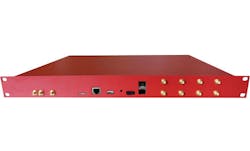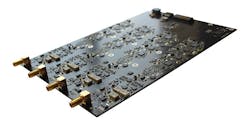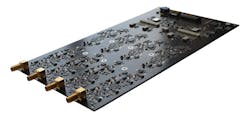This file type includes high resolution graphics and schematics when applicable.
Software-defined-radio (SDR) technology provides the flexibility that allows a well-designed radio to adapt to many different conditions. The Crimson SDR from Per Vices is an excellent example of that technology, fueled by effective analog and digital circuitry, along with the frequency range and wide operating transmit and receive bandwidths to 6 GHz.
The compact, efficient radio features four independent receive chains and four independent transmit chains to handle applications for commercial, industrial, and military users with outstanding performance levels and high reliability. The independent channels are also well suited for multiple-input, multiple-output (MIMO) communications systems.
Communications systems based on SDRs offer great flexibility due to their programmability. Because such radio designs combine RF/microwave, analog, and digital circuitry, they can be programmed in the field (even remotely), to handle a wide range of carrier frequencies, carrier bandwidths, and even advanced modulation formats. Software is a vital part of the effective operation of these radios, and software can still be one of the costlier components in assembling an SDR system. (Those seeking background information on SDRs can find it within the articles “SDR Technology Targets Flexibility and Security” and “SDRs Leap Ahead with Software and Processor Advances.”)
The Crimson radio combines the latest advances into an SDR with a great deal of flexibility and processing power (Fig. 1). The radio is housed in a relatively small enclosure for ease of integration with other systems. It handles a total operating frequency range of 100 kHz to 6 GHz using multiple signal channels and processors. It can tackle as much as 800-MHz bandwidth by means of four independently controllable receive channels and as much as 800-MHz bandwidth using four independently controllable transmit channels.
Frequency stability starts with an internal reference source based on a 10-MHz clock oscillator with ±5 ppb stability. The reference oscillator is designed to hold that frequency stability across a wide operating temperature range, enabling the radio to provide reliable communications under realistic operating conditions—even on the battlefield.
The Crimson receive section (Fig. 2) achieves small-signal gain of 67 dB. The high gain enables the SDR to detect even low-level signals, with a typical sensitivity of -110 dBm. At the high end of the dynamic range, the receiver provides a 1-dB power compression point (P1dB) of typically -11 dBm. It boasts a signal-to-noise ratio (SNR) as good as 73 dB with a spurious-free dynamic range (SFDR) of 55 dB at 200 MHz.
The SDR’s transmit section (Fig. 3) achieves maximum transmit power of +10 dBm at 6 GHz, with a typical P1dB of +14 dBm. The transmitter offers a spurious-free dynamic range of 61 dB from DC to 500 MHz. As the printed-circuit boards (PCBs) for the SDR’s receive and transmit sections show, the radio is based on a modular architecture which helps greatly simplify assembly during production and—later, if necessary—maintenance of different portions of the SDRs.
Of course, data converters are vital to the success of any SDR, and the Crimson radio builds upon analog-to-digital converters (ADCs) and digital-to-analog converters from Texas Instruments. Among other traits, data converters for SDRs should provide high resolution and operate with low power consumption, especially in support of portable radios. For example, on the receive side, the SDR features a model ADC16DX370 dual 16-b ADC capable of 370-MSamples/s sampling rate and generating 7.4-Gb/s JESD204B-compatible outputs.
This ADC achieves a typical full-scale signal-to-noise ratio (SNR) of 69.6 dB and full-scale spurious-free dynamic range of typically 88 dB. On the transmit side, Crimson SDRs rely on model DAC38J84 current-source DACs from Texas Instruments. These are quad-channel, 16-b converters capable of operating to 2.5 GSamples/s.
Armed with captured data, an effective SDR must also provide the means to process that data, and such capability comes within the realm of an SDR’s digital-signal-processing (DSP) circuitry. As the case in many SDR designs, much of the DSP actions are taken on by a field programmable gate array (FPGA). In the case of Crimson, the FPGA is an Arria V (model 5ASTMD3E3F31I3N) from Altera, with an on-chip dual-core Cortex-A9 processor from Advanced RISC Machines (ARM).
This processing power is fueled by the SDR’s high-stability 10-MHz reference clock. The internal signal processing power in the Crimson SDR is invaluable for flexible, reliable, high-speed communications, but it also enables backhaul and other types of connections to existing wired and wireless communications networks, by means of dual 10-Gb/s Ethernet backhaul connections on board the Crimson radio.
Crimson SDRs are ideal for any number of different applications, including for mobile backhaul connections and wireless base stations; for spectrum allocation analysis; for signal recording and spectrum monitoring in different communications systems; and for near real-time signal analysis in practical systems and in research setups. The radios are equipped for commercial, industrial, medical, and military use, where flexibility is an asset and maintaining communications security is a concern.
For those who may be hesitant about adopting SDR technology because of the software side of these radios, the supplier is willing to share the beta version of its Crimson radio user interface to help simplify setting up and using Crimson SDRs in any number of different applications.
Per Vices Corp., Toronto, Ontario, Canada; (647) 534-9007
This file type includes high resolution graphics and schematics when applicable.
About the Author
Jack Browne
Technical Contributor
Jack Browne, Technical Contributor, has worked in technical publishing for over 30 years. He managed the content and production of three technical journals while at the American Institute of Physics, including Medical Physics and the Journal of Vacuum Science & Technology. He has been a Publisher and Editor for Penton Media, started the firm’s Wireless Symposium & Exhibition trade show in 1993, and currently serves as Technical Contributor for that company's Microwaves & RF magazine. Browne, who holds a BS in Mathematics from City College of New York and BA degrees in English and Philosophy from Fordham University, is a member of the IEEE.




